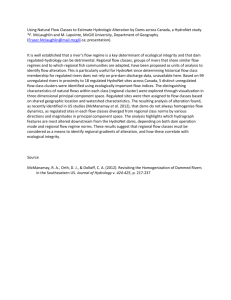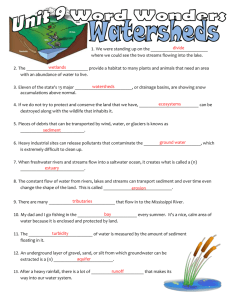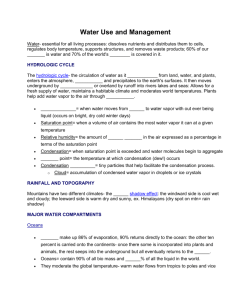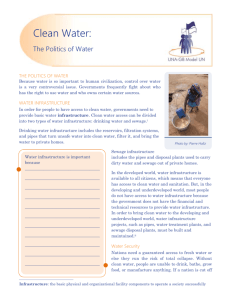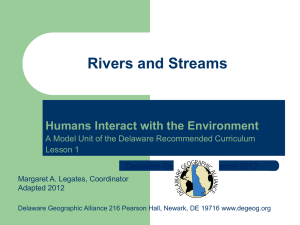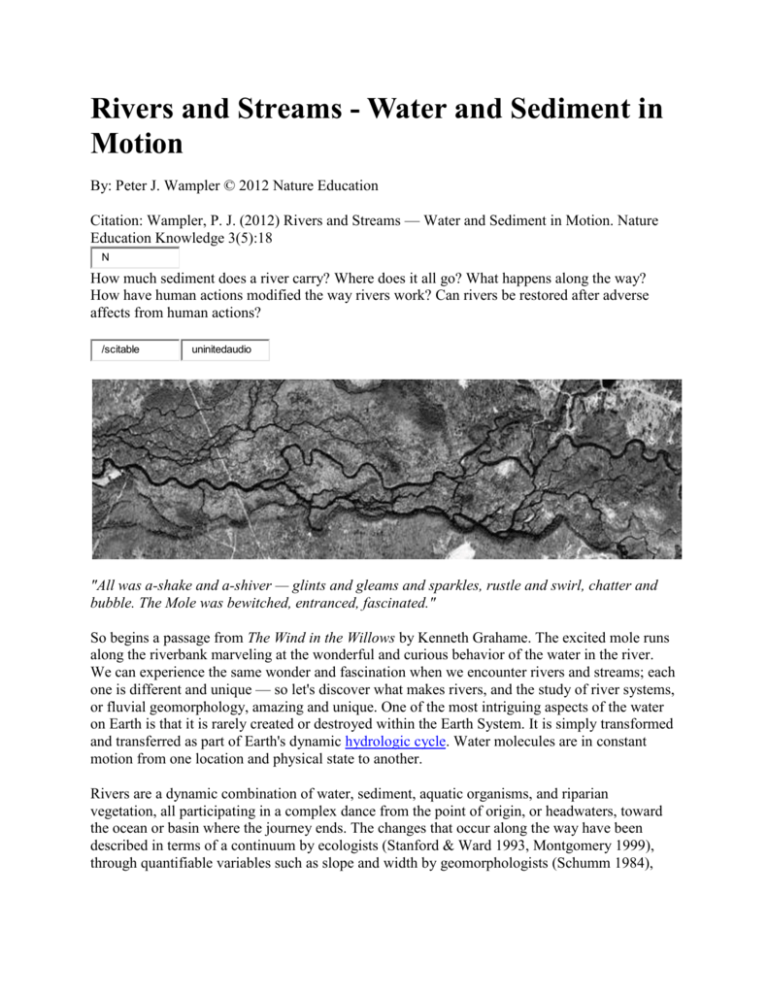
Rivers and Streams - Water and Sediment in
Motion
By: Peter J. Wampler © 2012 Nature Education
Citation: Wampler, P. J. (2012) Rivers and Streams — Water and Sediment in Motion. Nature
Education Knowledge 3(5):18
N
How much sediment does a river carry? Where does it all go? What happens along the way?
How have human actions modified the way rivers work? Can rivers be restored after adverse
affects from human actions?
/scitable
uninitedaudio
"All was a-shake and a-shiver — glints and gleams and sparkles, rustle and swirl, chatter and
bubble. The Mole was bewitched, entranced, fascinated."
So begins a passage from The Wind in the Willows by Kenneth Grahame. The excited mole runs
along the riverbank marveling at the wonderful and curious behavior of the water in the river.
We can experience the same wonder and fascination when we encounter rivers and streams; each
one is different and unique — so let's discover what makes rivers, and the study of river systems,
or fluvial geomorphology, amazing and unique. One of the most intriguing aspects of the water
on Earth is that it is rarely created or destroyed within the Earth System. It is simply transformed
and transferred as part of Earth's dynamic hydrologic cycle. Water molecules are in constant
motion from one location and physical state to another.
Rivers are a dynamic combination of water, sediment, aquatic organisms, and riparian
vegetation, all participating in a complex dance from the point of origin, or headwaters, toward
the ocean or basin where the journey ends. The changes that occur along the way have been
described in terms of a continuum by ecologists (Stanford & Ward 1993, Montgomery 1999),
through quantifiable variables such as slope and width by geomorphologists (Schumm 1984),
and through concepts of landscape evolution by tectonic geomorphologists (Burbank &
Anderson 2001).
The shape of rivers and streams changes through time as erosion, deposition, and transport of
sediment occurs. Rivers and streams maintain a dynamic equilibrium between discharge, slope,
sediment load, and sediment size (Lane 1955). Long-term shifts in equilibrium observed in the
landscape can result from climate change, tectonic uplift and subsidence, local base-level
changes due to landslides and damming, and hydrologic changes resulting from human activity
such as dams and irrigation diversion. Base level is defined as the imaginary horizontal level or
surface to which sub-aerial erosion proceeds (Schumm 1993). Several models to describe the
evolution of river morphology have been proposed. Davis (1899) viewed the rivers on the
Colorado Plateau of the United States as progressing from youthful to old age life stages. Davis
(1902) also introduced the concept of a graded stream, where erosion and deposition are in
balance. Mackin (1948) described a graded stream as "one in which, over a period of years, slope
is delicately adjusted to provide, with available discharge and with prevailing channel
characteristics, just the velocity required for the transport of the load supplied from the drainage
basin." More recently researchers have used complex computer models to understand landscape
evolution through a balance between tectonic uplift (mountain building) and denudation
(erosion) processes (Burbank & Anderson 2001).
Why is it important to understand and learn about rivers? Since the earliest recorded human
history, rivers have been the lifeblood, highways, and pantries of the world. Settlements and
towns have emerged and thrived near rivers and streams because of the water they contain, the
transportation they provide, and the life that they support. They are dynamic, interesting, and
beautiful; but they can also be dangerous and unpredictable. Immovable human settlements and
towns located near rivers are often in conflict with the natural and dynamic nature of many river
systems. This geographical collision sometimes results in catastrophic loss of property and life.
On the evening of July 31, 1976, residents of Big Thompson Canyon in Colorado tragically
learned the power of rivers to transform from serene picnic locations to raging torrents capable
of amazing destruction. Thunderstorms hovered over the watershed of the Big Thompson
Canyon dropping over a foot of rain in a period of three hours
(http://www.noaanews.noaa.gov/stories/s688.htm). A wall of water 19 feet high carrying huge
boulders raged into the town killing 145 people in a matter of minutes.
Rivers, although potentially dangerous, also possess great power that can be harnessed for many
beneficial uses including commerce, hydroelectric power generation, and irrigation of farmland.
The largest river in the United States, the Mississippi River, provides an important commercial
route for goods and services from the entire Midwestern United States. The power of the river
exists as kinetic energy, the amount of water passing a given point (discharge) and vertical
distance that water falls (hydraulic head) determine the amount of power that can be generated.
The majority of the large hydroelectric projects in the United States are in the mountainous
western states of Oregon, Washington, Idaho, and California. The Corps of Engineers maintains
a database of dams in the United States where you can learn more.
The recovery of energy from rivers and streams through the construction of dams comes at a cost
to ecosystems and the function of river systems. Dam construction can result in changes to
sediment transport, aquatic ecosystems, and migratory fish species such as salmon and steelhead
trout (Grant et al. 2003, Collier 2000). The capture of sediment behind dams can have profound
impacts on the geomorphology and function of the river downstream from the dam. The water
released below the dam has been termed "hungry water" because it has sufficient energy to
transport sediment but the sediment has been captured behind the dam (Kondolf 1997). The
"hungry water" consumes the bed and banks of the river below the dam, resulting in
entrenchment and armoring of the bed (Figure 1). Efforts are underway at many dams in the
northwestern United States to mitigate for the interception of sediments by adding sediment,
referred to as augmentation, below dams. This process replaces all or part of the sediment load
carried by the river prior to dam construction so that sufficient sediment is available below the
dam for spawning fish, habitat structures, and ecosystem function (Figure 2). The size of the
gravel added varies depending on the goals of the gravel augmentation plan. Gravel for spawning
gravel is typically 14–35 mm, while a range of sizes may be used to restore geomorphic structure
(gravel and sand bars) is desired (Kondalf & Wolman 1993).
/scitable
uninitedaudio
Figure 1: Entrenchment and absence of sediment below River Mill Dam on the Clackamas River
in Oregon.
The left bank is bedrock and gravel storage in bars is almost non-existent.
© 2012 Nature Education All rights reserved.
/scitable
uninitedaudio
Figure 2: Spawning size gravel added to the Clackamas River (upper part of photo) in 2003.
Part of a pilot project to restore normal sediment transport and replenish spawning gravel beds
downstream of the dam (Photo taken in 2010).
© 2012 Nature Education All rights reserved.
The detention of water behind the dam can also have profound impacts on aquatic ecosystems.
For example, when Hoover Dam was constructed in Arizona, it created the largest reservoir in
the United States. Due to its size and depth, the water in Lake Mead is not warmed by solar
radiation as much as the Colorado River was prior to the dam construction. As a result, the water
released below the dam is significantly colder, and the aquatic species populations below the
dam have been profoundly changed (Marsh 1985). Fish populations formerly dominated by
warm water species are now dominated by cold water trout species below the dam for several
miles.
Rivers and streams also provide crucial pathways for aquatic and terrestrial organisms to move
and migrate to find food and avoid predators. Riparian corridors can be 100's of kilometers wide
or mere centimeters. Anadromous species take advantage of the aquatic highways to migrate and
spawn in regular cycles tied to rainfall and seasons. For example, in the Pacific Northwest
salmon migrate into river systems and travel upstream to the headwaters where they were born.
The salmon spawn and lay their eggs in the gravel bed of the stream. The salmon fry emerge and
travel downstream to the ocean where they grow and feed until it is their turn to return to their
birth waters and spawn. Dams and other modifications to river systems can prevent salmon, and
other anadromous species, from returning to their birth streams. Turbines used to generate power
at dams are harmful to the smolts, or young salmon, as they attempt to return to the ocean.
Estimates vary for each dam and river system, but as much as 10% of the smolts can be killed by
turbines from a single large dam. If a river system has multiple dams the impact can be
devastating to anadromous fish populations.
Humans have modified many rivers and streams to the point where they no longer provide
valuable ecosystem and aquatic corridor functions. Watershed groups, government agencies, and
non-profit groups are playing a critical role in restoring river functions through watershed plans
and restoration activities. In order for river restoration efforts to be successful, it is necessary to
understand what the river morphology and function was prior to human modification (i.e., what
did the river look like and how did it function before modification?). Only after understanding
and agreement is reached on prior conditions can restoration activities begin to restore function
and morphology. Two broad conceptual approaches to restoration are typically used for
restoration design and implementation: 1) hydraulic engineering and erosion resistant structures
(Shields et al. 2003), and 2) reference reach mimicry and soft structures composed of vegetation
and natural materials (Rosgen 1996). Montgomery (2002) combines elements of both of these
conceptual approaches to arrive at a method which considers both quantitative geomorphic
parameters and reach-specific characterization (Montgomery & Buffington 1997, Montgomery
& MacDonald 2002). Because rivers are dynamic and changing, restoration must allow for the
river to remain dynamic to be successful in the long term. The hydraulic engineering approach
typically involves detailed numerical modeling of the river systems using tools such as HECRAS (Brunner 2002) to model water velocities under different flow regimes so that stable
structures can be engineered. This approach typically requires extensive cross-section surveys
and assumptions about model parameters such as bed roughness (Manning's n value). The
reference reach approach has become more common in the last two decades, partly in response to
a failure of some engineered structures built within dynamic river systems. This approach,
championed by David Rosgen, involves classifying the river system to be restored based on a
number of metrics related to channel form such as width to depth ratios, bed composition, and
other variables that characterize a stream reach (Rosgen 1994). Once the river or stream has been
classified, a reference reach is subjectively chosen as the goal of the restoration plan and
reshaping and revegetation transform the impacted reach into a river or stream which mimics the
reference reach parameters. Advocates for this approach argue that it is more compatible with the
unpredictable and dynamic nature of rivers, while advocates of the hydraulic engineering
approach argue that the numerical certainty provided by the computer models provides better
restoration solutions.
A wealth of data and information about rivers is available on the internet. One of the most
interesting and compelling data sources is the United States Geologic Survey web site where
river flow for thousands of rivers across the Unites States can be viewed in real-time on a color
coded map. A series of excellent, on-line activities, to learn about flood frequency and discharge
are also available at the Virtual River web site. The next time you find yourself walking along a
river bank, take time to explore for yourself and see what you can learn about these dynamic and
beautiful places.
References and Recommended Reading
Brunner, G. W. HEC-RAS River Analysis System. Hydraulic Reference Manual. Davis, CA:
United States Army Corps of Engineers, Hydrologic Engineering Center (HEC), 2002.
Burbank, D. W. & Anderson, R. A. Tectonic Geomorphology. Blackwell Science, 2001.
Collier, M., Webb, R. H. & Schmidt, J. C. Dams and Rivers; A Primer on the Downstream
Effects of Dams. Reston, VA: United States Geologic Survey, 2000.
Davis, W. M. The geographical cycle. Geography Journal 14, 481–504 (1899).
————— Base level, grade, and peneplain. Journal of Geology 10, 77–111 (1902).
Grant, G. E., Schmidt, J. C. & Lewis, S. L. "A geological framework for interpreting
downstream effects of dams on rivers," in A Peculiar River, eds. J. E. O'Connor & G. E. Grant
(American Geophysical Union, 2003) 209–225.
Kondolf, G. M. Hungry water: Effects of dams and gravel mining on river channels.
Environmental Management 21, 533–551 (1997).
Kondolf, G. M. & Wolman, M. G. The sizes of salmonid spawning gravels. Water Resources
Research 29, 2275–2285 (1993).
Lane, E. W. The importance of fluvial morphology in hydraulic engineering. Proceedings of the
American Society of Civil Engineering 81, paper 745, 1–17 (1955).
Mackin, J. H. Concept of the graded river. Bulletin of the Geological Society of America 59,
463–512 (1948).
Marsh, P. C. Effect of incubation temperature on survival of embryos of native Colorado River
fishes. The Southwestern Naturalist 30, 129–140 (1985).
Montgomery, D. R. Process domains and the river continuum. Journal of the American Water
Resources Association 35, 397–410 (1999).
Montgomery, D. R. & Buffington, J. M. Channel-reach morphology in mountain drainage
basins. Geological Society of America Bulletin 109, 596–611 (1997).
Montgomery, D. R. & MacDonald, L. H. Diagnostic approach to stream channel assessment and
monitoring. Journal of the American Water Resources Association 38, 1–16 (2002).
Rosgen, D. L. A classification of natural rivers. Catena 22, 169–199 (1994).
————— Applied River Morphology. Pagosa Springs, CO: Wildland Hydrology, 1996.
Schumm, S. A. River response to baselevel change: Implications for sequence stratigraphy. The
Journal of Geology 101, 279–294 (1993).
————— The Fluvial System. New York, NY: John Wiley and Sons, 1984.
Shields, F. D. et al. Design for stream restoration. Journal of Hydraulic Engineering 129, 575–
584 (2003).
Stanford, J. A. & Ward, J. V. An ecosystem perspective of alluvial rivers: Connectivity and the
hyporheic corridor. Journal of the North American Benthological Society 12, 48–60 (1993).


